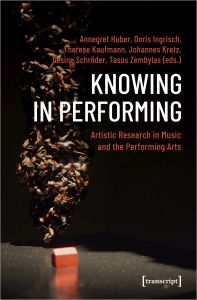Knowing in Performing. Artistic Research in Music and the Performing Arts. Edited by Annegret Huber, Doris Ingrisch, Therese Kaufmann, Johannes Kretz, Gesine Schröder, and Tasos Zembylas

A symposium and a lecture series that took place in 2018 at the mdw have now given rise to the open-access multi-author volume Knowing in Performing, which includes contributions in English and German and is an enriching read both for those who are familiar with and/or themselves active in the field of artistic research as well as for anyone who is interested in learning about what artistic research is in the first place—or about what concepts such as artistic research, arts-based research, and research-based art stand for. The contributions to this volume shed light from various perspectives on the epistemic potency of a threshold (always also a zone of ambivalence and indeterminacy) at which a thing of art (the product, result, or even process of an artistic practice) can become a medium of artistic and academic research. In so doing, the individual contributions succeed in sharpening one’s awareness of this double-lens: of the possibility of viewing something simultaneously as art and as an episteme, and of the challenge—or even provocation—to the established academic register and knowledge regime as well as institutional research models that this entails (cf. Introduction, p. 7, as well as the chapter by Efa Lilja in particular).
The focus of this volume would appear to be (but is not exclusively) musical artistic practice: the range of phenomena examined here extends from the “classic” instrumental performance situation (such as with various types of violins playing before an audience, expanded upon in the chapters by Kanno and/or Lüneburg; or the materiality and ephemerality of digital sound, cf. Bovermann/Schilling/Grill/Leibetseder) to doing theatre in settings that include university-level institutions (Holkenbrink), academic conversations with artists (Ingrisch), the performative art of philosophising (Böhler/Granzer), the hybrid artistic and academic method of autoethnography (Crispin), and on to “everyday disciplines” such as bread-baking and hammering (Coessens). In all of these areas, the active role of reception (i.e., that of the audience) is given special emphasis, ultimately facilitating the discovery of “new patterns of learning, of communicating, and of working (p. 141).
Conspicuous and to be welcomed are the concerted efforts made in many of the contributions here to not just report about a phenomenon or example relevant to artistic research but also—taking up the idea of the double-lens—write about artistic research in the mode of artistic research—i.e., experimentally, and perhaps also “risking one’s authority and assurance” (Holkenbrink), even if it does put certain publication conventions to the test. This not only encourages a new way of listening (Kreidler) but also quite necessarily calls for a new way of reading. For as Lüneburg formulates in her chapter:
“Artistic research operates with forms of knowledge that one cannot investigate using scientific research methods alone. To this category belongs knowledge based on and gained through artistic practice, as well as the knowledge that manifests itself through the results of artistic practice for which experience with the artwork is essential. Artistic research strives for alternative possibilities to communicate these forms of knowledge. The essential difference between artistic and scientific research is that in artistic research, the goals and methods for acquiring knowledge are infused with the posing of questions that stem from the structured and reflective direct involvement of the artist in the process of creating the work and the artwork itself.” (p. 187)

